I don’t really have a better word for it yet, and I confess the name is truly wrong for both disciplines… but together they make a kind of sense. I began fiddling with leafing about six months ago, and have continued to revisit it again and again, sometimes in making unique pieces with the leaf, but largely relying upon its natural quality to adorn by utilizing it to embellish special edition prints for DUNE, THE LAST OF US, etc… there’s a remarkable beauty to this kind of adornment on existing color work and it certainly fits in with my own preordained love of for flat cutout outs and negative spaces set against really rendered practical art. I am by no means a professionally schooled person when it comes to gold-leafing. OR sumi-e work for that matter. I am a technically professional artist who’s playing with these mediums the way a monkey might try to fiddle around with a cellphone: I occasionally make something happen that suits my monkey goals, but I wouldn’t be fool enough mistake that luck for training. I’m a monkey, but no ape. As I’ve been playing more and more with gold leafing existing prints, posters and some originals- all as an experiment to see what the material can lend and bend itself to… of COURSE I’m going to see if I can paint with it right?
Something beyond adornment and into doing something in its own right using it’s own voice…
I started as I said with trying it out on some old TWIN PEAKS prints and redraws of some work I did for Criterion’s ZATOICHI box set… and moved into the big 24×36″ posters and the Last Of Us prints as well. It’s something I really like to do for the final super deluxe editions of the APs, and will definitely persist in this new wing of my art sales ongoing. The first and big trick is to get the right glue for it. If you don’t already know, proper leafing adhesive is gloopy, like slightly overcooked elmer’s glue, dries clear, but remains extremely tacky. I have let pieces stand for over a week before getting to the leafing stage, and the masking tape style tack o the glue even after it’s beyond cured, never fades. The only mistake I’ve ever really made with it is being too impatient to wait and moving on to the leafing stage too soon- this causes splats, and bleeding smears that has had me toss whole pieces as a result. So be quick in applying the glue and patient when it comes to the leaf.
Now when it comes to the leaf itself, the kind you get DOES matter. I’ve mostly landed on proper 24k gold leaf, copper leaf and some sterling silver leaf. They’re much more expensive than their knockoff siblings i used at the beginning to figure it all out. REAL 24 k gold leaf is up around $150 per packet, BUT You should be able to get fake gold leaf for about $7 for a hundred sheets. And you can indeed get good flaking leaf for that price, so make sure to learn and cut your teeth on the cheap stuff first. In my experience, Japaense leaf, both cheap and expensive are superior overall. The stuff from China, while offering an array of colors and styles, doesn’t so much flake apart as it disintegrates into a kind of nano-glitter that is god awful to rid yourself of. You will know what I mean if you get some. it’s the WORST, and it also gets VERY imbedded into the fabric of the paper I work on making it hard to get off as well. I tried using a vacuum cleaner hose which worked, but the abrasions from the vac scraped the delicate leaf and drawing. In the end the best was using my bare hand as a kind o flint brush. But best to avoid. Gold leaf gets EVERYWHERE…. but this stuff seems to get in between the atoms that make up your universe. I used some of this stuff to red and blue leaf some Dr Strange prints… not worth it. The ebony, or black leaf is particularly interesting as a sort of beetle shell tonality… despite sadly sharing this same problem. I created the dot matrix portrait of Naz in this stuff and I will suffer it again because the final outcome is in fact, worth it.
I do not really use gloves, and am not what I would ever call delicate about the material- opting to hand slap it over the cured glue areas, and in the case of a field of little microdots created with my syringes and squeezer bottles, rub handfuls of the leftover leaf all around the surface of the piece to have it get snagged on each little orb of glue waiting for it. I’m not at all anti-education and training whatsoever, but I will say like with the sumi-e work I did for nearly 15 -20 years, going into it ignorant of the proper way to do it meant I was more free to think outside the limitations of traditional sumi work. The same goes for leafing. At least for now. I’m sure there’s nothing but good and important things to learn about the classical technique of leafing and I do aim to get there one day. But right now I think avoiding that inevitable cost from training: a narrowing of the way one thinks about a particular medium, makes the work more open to doing weird things with it. Like this below.
The big leap I was going to take was to use the glue to paint a sumi style drawing ands then leaf that. It seemed like it could work and the idea of making a brush stroke in gold seemed a deliciously decadent thing to pull off… if I could stick the landing. I first did a few random pieces to test the waters, mostly samurai cinema subjects, Toshiro Mifune, etc… It was tricky at first and in many ways the glue was a bit overly thick so I had to water it down… but not so much that it diluted too much the sticky tacky quality the glue is there to give.
If Sumi ink was brutal for my brushes, this stuff is worse. There’s almost no way to actually be rid of it until you really clean your brushes in soap and hot water… but never fear. Even getting them wet enough to dilute the glue from making it too stiff and ruinous… I’ve found you can get them back by cleaning them even after they’ve technically “dried”. I just don’t recommend using a good brush for this- the cheaper the better. Painting with glue is not a finesse thing and a real high end sable brush won’t make much a whit of difference to the piece that a cheap sack of nylon brushes will you get from Michael’s. I will say it’s best in my monkeyman experience with this stuff to initially hand rub off the big leftover chunks- it keeps them intact and easier to reuse later. I keep some mason jars around to fill with this and given the expense of this 24k goldleaf, it can add up to a lot. 24k is a very soft version of an already super soft metal, so even nonuniform sheet, like little piled chunks or handfuls of leftovers work well when you smooth over and burnish it.
So I find a big bushy makeup application brush works best for the initial brushing off. It does double duty as a polisher for the leaf that’s sticking around too. That said I do also rely on these stiff cheap hardware store disposable brushes for the next stage- where the tiny little channels and details I want to remove are largely missed by the makeup brush. You want to be careful to use the tips to sort of pierce the lead, dig in and under to reveal the spaces you’re trying to clear. Taking thew time to really get in there and pickup the most teeny pits and grooves. I always like to follow up on this stage with the makeup brush to give it a final clean and polish. There are fixers and sealers for gold leafing but I don’t recommend it when it comes to work on paper. Even this thick 300 gsm cotton rag can get wibble from the initial application of heavy amounts of the glue, as you can see here below in some to give the piece a raised texture and some sense of form and sculptural/relief elements. Just remember, with the beads and dot matrix work and especially some of this heavier glooped on sumi style pieces, the more the glue the more time you need to let that glue cure properly. I’ve found for the heavier loads it’s best to give it as much three full days or more. Remember it never really loses its tack if you’re using the right glue, so the longer you let it dry the better the result in the end.
… And then moved into a series of portraits and pieces from the most recent FX/Hulu miniseries, SHOGUN. The one thing about leafing like this, which again I’m entirely new to as a medium, is how absolute it is. There is no chance of any gray-scaling it. The glue is either there or it isn’t. One might be able to use stippling or very delicate line hatching to evoke a sense of that in between tonality… but even then it’s hard to get right. Gold leaf is an extremist. And no matter how much I was able to will the drybrush grey areas of those pieces to get some middle ground tones, the leaf does not abide that way. So there’s certain limits on it in that regard that I think might make this approach only slightly possible for specific things. It clearly worked best when the piece was strong in its graphic nature, more than not. I think the Mariko pieces seemed to do so well because of that exact dynamic, dark graphic hair, eyes and mouth, white skin and simple graphic bone structure. True as well for the horse work and some of the samurai armor.
I’ll continue to play with it and push and see what it can do, and am still searching to craft the perfect dispensing method to draw with- I’d love to do a recursive leaf piece, for example… but the syringe approach isn’t that yet. we’ll see. I am definitely going to play more with the dot matrix stuff… have a notion to do some landscapes with it… so stay tuned. I guess overall I am excited for the change and the new weirdo world of it, and there’s something truly fun about getting lost in the woods of the medium. Most of the gilding videos I’ve perused have to date been middle aged ladies and bearded gentlemen gilding frames or vases they got from Hobby Lobby, so not exactly a fountain of inspiration there. But it does give me notions of working on some 3D pieces and using the leaf there too… so we will see what we see. A testament to having fun and seeing where fun takes you. It’s a strange process, more mechanical than most I guess- and it has the weird quality of requiring you to stop and wait for things to dry or settle before you can move on to the next part. A stiltified sort of race of inspiration, but it’s rewarding in that even after doing twenty or thirty of these I am always surprised by what gets revealed in the final leaf removal. It’s a little like practical photography in that way: you become a witness to the work you made by way of the process required to see what you did in the first place.
All of the remaining pieces will arrive in the shop for a sale drop Friday May 17, 2024 at NOON EST.


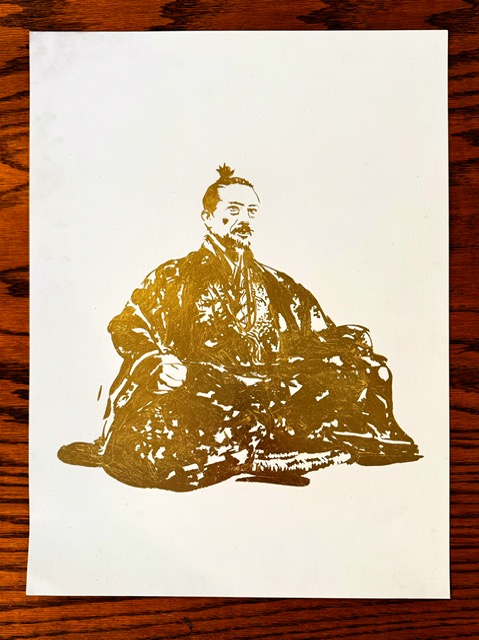

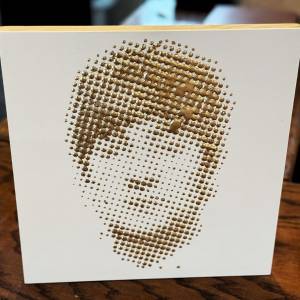
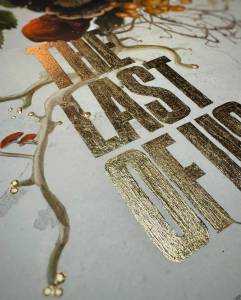

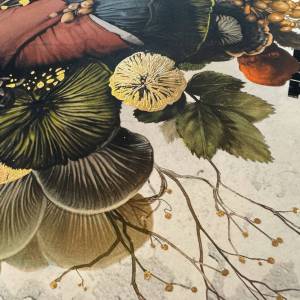


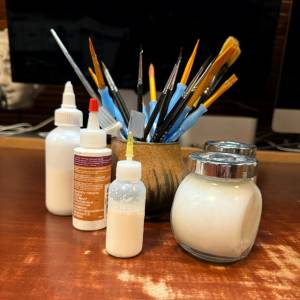

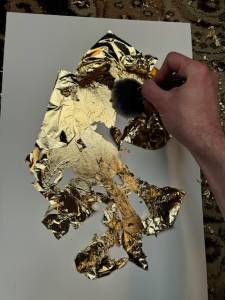




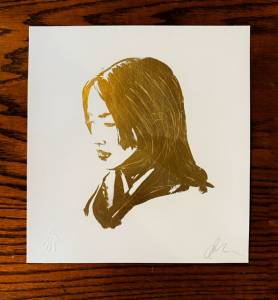


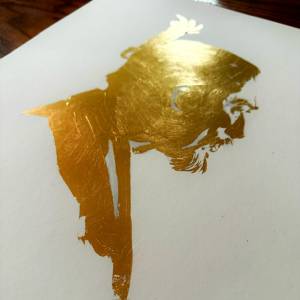



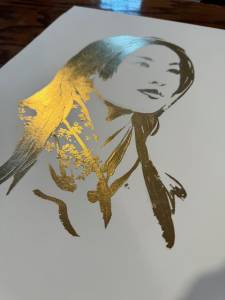

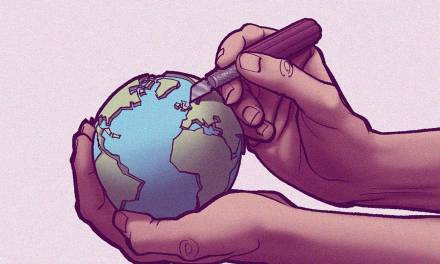
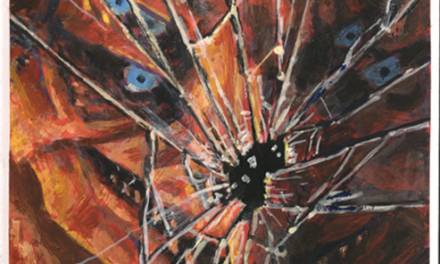
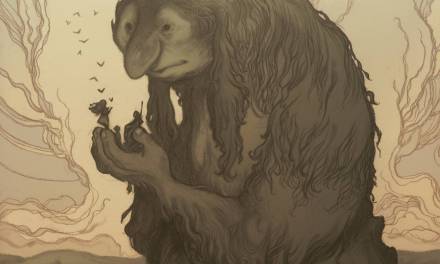
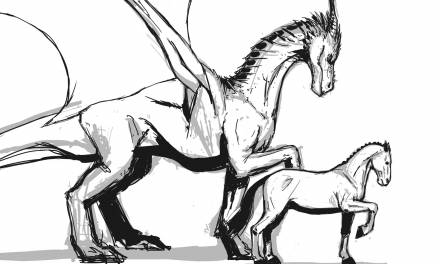
These look amazing. Was there no option of a simple gold paint that would let you do similarly? Or is the final lustre worth the effort?
THX Dan-Dos! Uhm not really I guess. It’s a question I asked myself a dozen times while doing these…
I suppose you could make a gold painted painting, that seems pretty basic and doable to me… but this is sort of engaging to me at least because it’s a process. Making a drawing with a pencil is a thing pencils do, making a drawing with a sandwich well, that’s something else… if you get my meaning. I think it’s the unconventional quality that’s capturing my interest in the process…. I love that the end result is a painted drawing made of metal. And that they are almost impossible if entirely so to capture with a camera or a scanner… you have to hold it to get the true effect of it. Especially when it comes to the details of the glue’s texture.
Additionally… gold paint just doesn’t have the same shine as actual 24k gold leaf. This stuff is a whole other animal.